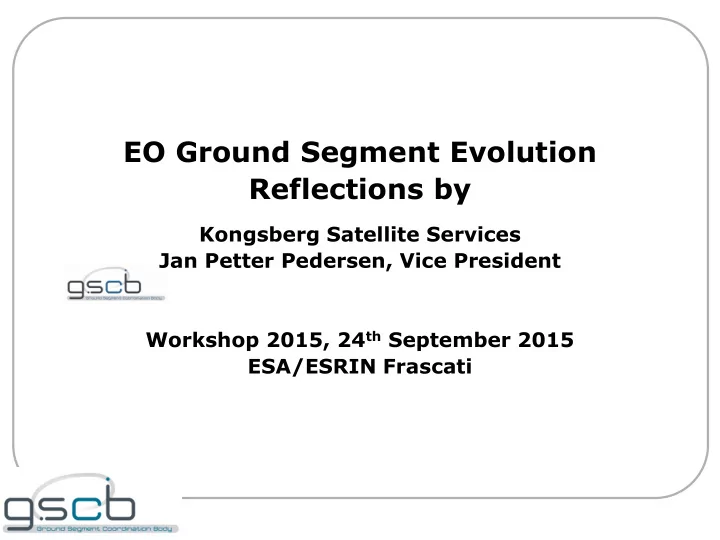

EO Ground Segment Evolution Reflections by Kongsberg Satellite Services Jan Petter Pedersen, Vice President Workshop 2015, 24 th September 2015 ESA/ESRIN Frascati
Com ompa pany ny Profi ofile le • Since 2002 (Tromsø Satellite Station, 1967) – Turnover 2014: ~60 Meuro – Result: +20 %, – Employees: 145, 8 nations – Annual growth rate: ~20 % – Export ~90 % • Satellite Operations – Ground segment & services – Tracking, commanding & control – Data handling – 85 satellites/day, 20 000 pass/month • Energy, Environment and Security – Multimission NRT data and information services – Maritime primary domain – Land developing
Ex Expe pertise rtise an and d ac activi tivitie ties s rel elev evan ant t fo for fu futu ture re EO Grou ound nd Seg egme ments nts an and S d Ser ervices vices • Multimission services infrstructure • One customer point of contact • 20years+ space agencies, commercial • Next generation infrastructure (cloud’s) • Ground segment activities – Launch ->Mission end support – Global network S/X/C-band, Tromsø core – Copernicus Ground Segment (core, collab) – Meteorological, SAR, HR optical missions • NRT(~15min) EO based services – Agreement for «all» SAR missions – Additional (Sat)AIS, database, models, .. – Deliveries for operational/tactical use – Oil spill detection (EMSA CSN, global) – Vessel detection – Ice information (-edge, -bergs) – Metocean (Wind, wave, current)
Ref eflecti lection on on on Grou ound nd Seg egme ment nt Ev Evol olution ution Ref efere erence nce Pa Pape per (1) 1) • Important to harmonise and standardise the evolution of the various mission ground segments, to ease – Multimission service providers working environment – User’s access to data • Bridge gap between data and users, i.e. making data available to users in a technical and programmatic more cost-effective way • Free and open data focus, but national/commercial and non- European missions important and need to be fully considered. • Challenge to serve variety of users ranging from need for data and processing services towards information & decision input • Industrial capacity and capability exists, investments are being done. Find roles and responsibilities, e.g. for ESA vs industry
Ref eflecti lection on on on Grou ound nd Seg egme ment nt Ev Evol olution ution Ref efere erence nce Pa Pape per (2) 2) • Interoperability – Simple, clear interfaces towards data sources, processing, etc. – Not developed by researchers that never worked in an operational setting. • Enlarge EO data usage by – Making data easily available: Higher processing levels, no multiple logins, no explanation why or how to use it. – Bringing users to the data will result in new innovative applications – Organisations that deliver data services to be paid for the costs involved. – Easy to use simple APIs and interoperability to allow "non EO experts" to get access to data at all levels • Platforms and technologies. – Industry will maintain competitive edge and not provide it for free and open. – Need to balance competitive advantages and IPR on value-adding vs «open source» – Example: ESA TEP tender; Industry & public access to competitive knowlegde
Expe pecta ctations tions an and R d Rec ecommen ommenda dations tions • Europe has a developing industrial service capacity – not only on space and mission technolgy. Maintain industry opportunities and IPR’s versus Core GS’s , public services and in-sourcing. • Support and stimulate new, innovative and small actors who want to create new " app’s" – and not brining all “open source”. • Innovation Europe focus on European advantages e.g Copernicus, important to include the world outside (likely not «free and open») because it is needed to serve real operational customer needs. • Needs for documentation has increased e.g. in European projects. Consider necessity of all documents vs use of resources towards the users.
New and innova vative tive space ce applic licati ation ons GSCB Workshop, ESA/ESRIN (Frascati) 18 th – 19 th June 2009
Recommend
More recommend